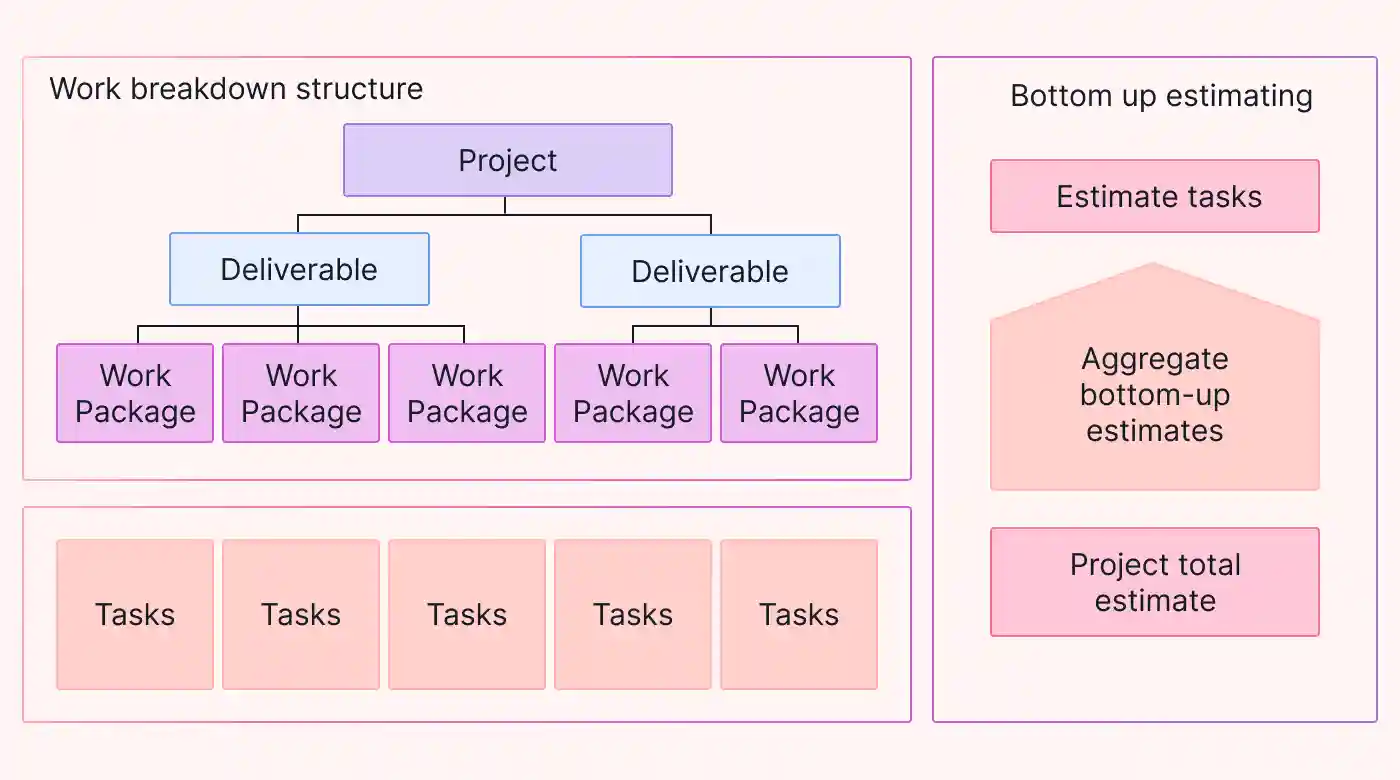“How long is it going to take?”
“How much will it cost?”
How do you answer when your client or potential client asks you these pointed questions? When estimating projects, it’s crucial to be accurate. The last thing you want to do is run the risk of coming back to your client halfway through a project, asking for a six-month timeline extension or a six-figure budget increase.
Choosing the right estimation method from the beginning is the key to dialing in estimations for your project time and cost. Consider the bottom-up estimation technique for the most accuracy.
What is bottom-up estimating?
The words “bottom-up” give you the first real clue about how this estimation technique works. Bottom-up estimating is when you build your estimates from the most granular level of work needed in a specific project and estimate “up” from there to the bigger picture of the project. The superpower of this estimation technique lies in its unparalleled specificity.
To estimate from the bottom means you start by breaking all project deliverables within your scope into their smallest components. This creates a work breakdown structure (WBS) to estimate all the details of the lowest level of work needed and then add them up as you work up to the larger activities of a project. You can get to the discrete details by breaking the project into smaller deliverables and then individual tasks. If you work in a digital agency and the project is a sleek new website for a client, your scope might include three pages and an online shop. You’ll take these deliverables and break them down even further with the help of your coworkers.
You could determine in this example that two main teams are needed for this project: visual and technical. The visual team will take the site idea and break each page into layouts and designs to reflect branding and ease of use for customers. The technical team of developers will then build the site’s backend for functionality and security and then implement those visual tasks by writing code so that users see those beautiful visuals when they visit the site online.
Each big chunk of work will get broken down by those teams into smaller and smaller tasks. The smallest task will get an estimate determined by one or more subject matter experts (SMEs) on that team. When a senior developer estimates hours or effort into a task, you can trust its accuracy! (Well, you have to take into account the skill levels of the resources who will DO the work).
 |
The bottom-up approach works only if each task is individually identified and estimated. This means your estimates are going to be unique to the project at hand you’re looking at, so no two bottom-up estimates will look alike across your projects. It requires time and overhead from SMEs to estimate every little detail of a unique project. It also means these estimates are not going to be one-size-fits-all. You might put a lot of work into estimating this site’s scope of work, but you can’t expect to reuse those numbers for another client’s site later.
Why you should try bottom-up estimating
There are some really good reasons why bottom-up estimating is always near the top of the list of estimation techniques. One of the biggest reasons to use this method is that according to PMI, its accuracy is better than analogous or parametric estimating. (Some would disagree).. By putting so much effort into identifying specific tasks and asking SMEs to provide estimates, you also ensure your overall estimate has a low margin of error.
Your team of experts are going to have a firm grasp of how much effort a task will take, whether it’s designing a visually compelling component like a banner on your client’s site or a developer estimating how many hours it will take to write the code that updates the number of products left in the online store inventory. It’s unlikely that a project manager or any stakeholder will need to go back through these estimates and make adjustments. Leaning on your SMEs from the start of the process ensures a high level of accuracy.
When you decide to estimate from the bottom up, you bring in your team members early. This can contribute to team building. By recruiting your SMEs to identify and estimate individual tasks, you’re a step ahead in team building and collaboration, laying the groundwork for smooth working relationships on the project. You’ll likely see more commitment in this estimating method because the team owns the estimates and is involved from the beginning.
Bringing the team in early also leads to better understanding of other elements of the project. Doing these estimates of individual task effort and duration, it’s much easier to determine costs, potential risks, blockers, and contingencies. This makes it much easier to pivot and accommodate changes as planning shapes up and can contribute to decreased risk.
How to make the bottom-up estimation technique work for you
When you decide to go with the bottom-up estimating technique, you might feel a little daunted by the amount of preparation involved. Don’t be overwhelmed. The prep work for this method is well worth the effort. Getting super granular right away can make your estimates even more accurate.
Step one: Identify your scope
Define your scope. Identify all deliverables and build out your Work Breakdown Structure (WBS). Only when you understand the scope in detail, down to the task level (or lowest level of the WBS), can you estimate the level of effort and resources needed. When you understand that, you can estimate the time and cost for each and add them up from bottom to top to get an estimate for the entire project.
In our example, your digital agency has acquired a project with a client that needs a great new website for their company. The site needs three pages and an online shop. One page is the homepage. Another page features different products, and the third page is for testimonials from happy customers. Once you identify the project team, the SMEs can start to deconstruct the site into smaller chunks of work and requirements.
Requirements of course depend on your specific project. Requirements include client expectations and all resources needed. Resources don’t just mean teammates and the skills they bring to the project. Resources might also include specific equipment, supplies, and facilities.
In your digital agency, this could include laptops for your employees, for example, if a particular client requires Macs instead of PCs to build their site. Some training might be needed, as well, if the environment is sufficiently different from what your internal team has used before.
 |
Step two: Use subject matter experts (SMEs) to drive task estimations
This is one of the biggest reasons bottom-up estimates are so accurate. When you rely on your team experts to weigh in on work effort and task estimates, you benefit from several points of view on the level of effort required for a project. In your digital agency, for example, you will ask your seasoned website developers to lay out the tasks needed to implement the visual team’s beautiful new design into working code.
Step three: Estimate cost
Once you’ve gathered requirements, broken your scope into tasks, and estimated their level of effort and durations, you can start to assign dollar amounts to each. You can estimate the cost of equipment and supplies and the hourly rates times the estimated level of effort of your employees on each task.
Because your team experts have dug into the needed tasks, they have also been able to dial in on contingencies that might affect costs that might not have been visible from the project’s earliest planning stages. For example, to achieve the level of performance required to support the new system, the client may need to invest in a new hosting platform, or other accommodation to best support the features they want on their new site. Your technical SMEs will find these nuances, and you can build them into your estimates.
Step four: Estimate timeline
The bottom-up approach can be used for both cost and schedule. Sizing up the potential schedule has an effect on cost estimates. This is because you have a daily “burn rate” just to keep members of the team on the project. That’s there, no matter how many hours you plan to spend. For example, if your project runs behind schedule, your burn rate keeps on “burning” for longer than you originally planned during scheduling.
To set yourself up for success in timeline planning, you have to determine task dependencies and durations. Unless you’re talking about how long it will take cement to dry, duration for tasks requiring human resource is calculated as effort divided by the number of resources you apply (within reason). This will help develop the most accurate schedule. By adding up the durations of everything on the critical path, you have project duration, to which you might want to add contingencies for extra flexibility.
Comparing bottom-up to other estimation techniques
Bottom-up estimating is not the only popular estimation technique out there. There are lots of other popular contenders. Let’s briefly explore how they’re different from bottom-up estimating.
The three-points method
This method considers three estimates based on prior experience when evaluating a task’s duration. These estimates are:
- The most optimistic estimate
- The most pessimistic estimate
- The most likely estimate
The most optimistic estimate is an estimate of how much work tasks might take in the most positive or ideal conditions. The most pessimistic estimate is how much work it might take under the most negative conditions, where identified risks may occur. The most likely estimate could also be considered the best guess estimate, or expected estimate, and it’s the average amount of work it might take to complete the task.. Think of this number as the safe bet. To use this method, triangulate all three numbers by averaging them to arrive at an approximate project estimate.
If you are using the PERT technique, the expected duration is calculated by giving the expected duration four times the weight of either the optimistic or most pessimistic estimate. You can read more about PERT here.
The analogous method
Comb through your previous projects to forecast the likely needs of your current project. This type of estimating can help guide your stakeholders through any potential sticker shock on cost and timeline because they can compare it to previous successful projects. This is a great technique if you don’t yet have a deep knowledge of the project and need a quick estimate based on data you can pull from past projects.
The parametric method
This technique also relies on looking at previous projects and basing estimations on how those projects performed. This technique works best when you have a database of projects performed earlier and have captured their actual performance parameters. This estimating method can scale well across projects of similar type and scope.
The top-down method
In top-down estimates, the client might come to you with what they can afford for a project. From that top number, you begin to break things down into resources, milestones, deliverables, and then level of effort and resources needed. Then you can tell the client what you can produce for the amount they can afford.
It’s very much the opposite of bottom-up estimating, because you’ll be working to build your project tasks to fit into the higher budget the client has available, instead of building the budget based on the work needed to be done.
More often, though, it is used early to make strategic decisions about whether a project should be taken on at all. In the initial stages, not enough is known about the project to develop the WBS to obtain detailed estimates of either cost or schedule. So a high level estimate done by senior managers based on similar projects. In that way, it is a form of analogous estimating.
A word on the cons of bottom-up estimates
While bottom-up estimating is seen by many as accurate and detail-oriented, it has some drawbacks. The biggest one to notice is that this technique is time-consuming. You – and your team – will spend considerable time discovering everything needed for the estimate.
These estimates can be costly. Before landing the project, you might be doing these estimations for free, for pitches, because clients often do not want to pay for the cost of task discovery and estimations. Even if you have a great client who agrees to a discovery and estimation phase, these estimations may take longer than you think, and you may be using billable resources for work that doesn’t directly yield any revenue or other direct business value.
Finally, these estimates require a good amount of data, or insight, into the client and project needs. Bottom-up estimates require a detailed understanding of the scope and available resources. You have to start from scratch for each unique project unless they are carbon copies, which might be the case in some industries, but would otherwise be unlikely. While this kind of estimating has many advantages, it’s only appropriate when your project is unique, and you have developed detailed knowledge of what is to be produced.
Get your estimates into Motion today
Let Motion help you nail down scheduling both your project and non-project work. Even your personal time and obligations.
Tell Motion your tasks, dependencies, resource assignments, available work times, time estimates, deadlines and priorities. Motion’s AI will serve them up on your team’s calendars, along with all their non-project work, to optimize their time. Your team won’t have to think about what to do next, because Motion will do that for them (and for you).
Motion won’t over-allocate your resources, because it knows their available work times. And, Motion will tell you if it can’t meet a deadline, or you’ve asked it to do the impossible, so you can adjust. If new priorities arise, Motion will intelligently adjust task work to accommodate the changes. Let Motion make your team more productive.
Try Motion free for seven days right now.

Keisha Card is a Senior Project Manager in the digital space who is passionate about knowledge sharing. Let's demystify all things project management and Agile!





